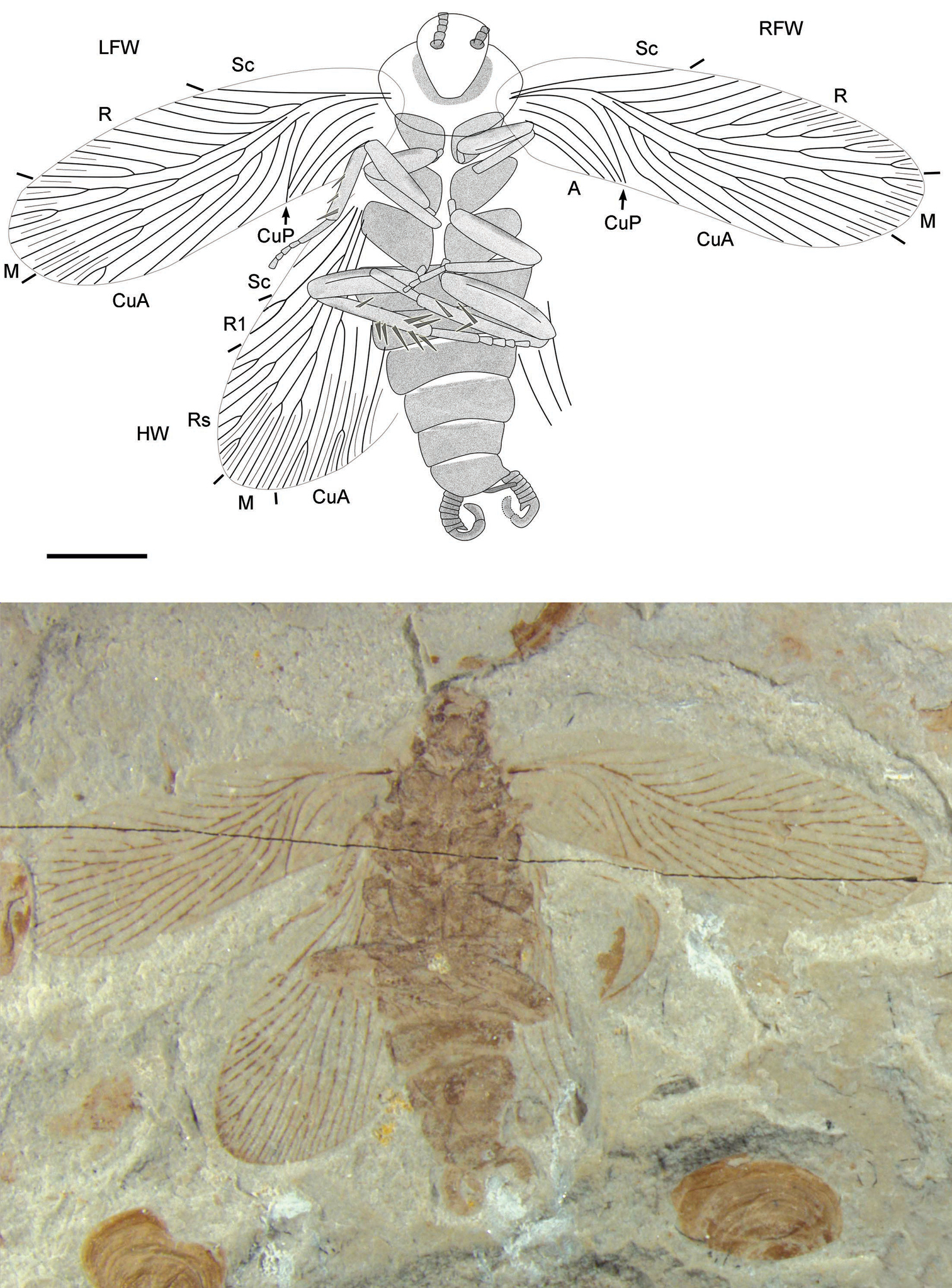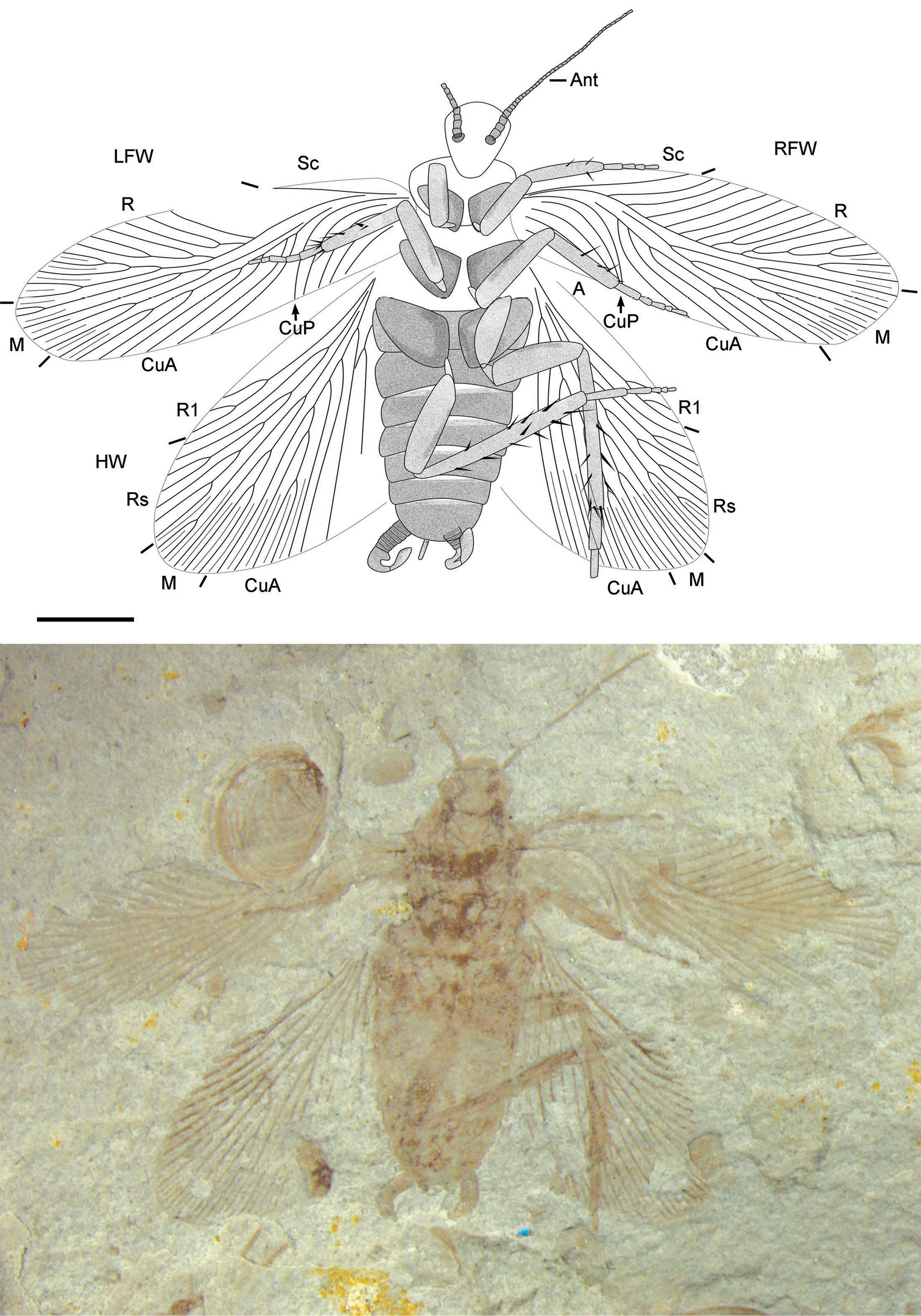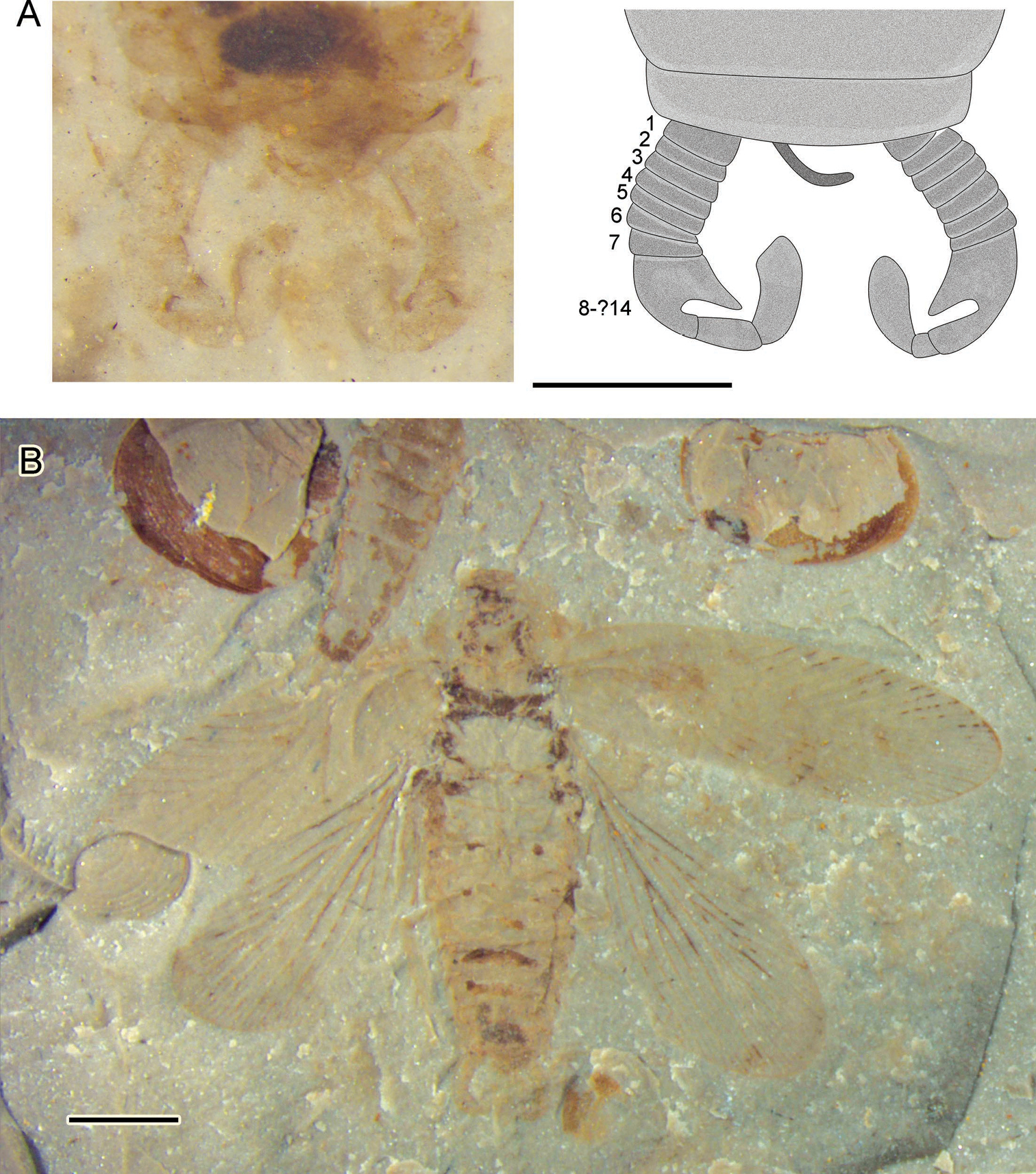






(C) 2012 Dandan Wei. This is an open access article distributed under the terms of the Creative Commons Attribution License 3.0 (CC-BY), which permits unrestricted use, distribution, and reproduction in any medium, provided the original author and source are credited.
For reference, use of the paginated PDF or printed version of this article is recommended.
A new species attributed to the genus Parvifuzia Guo & Ren, 2011, Parvifuzia peregrina sp. n., is described from the Middle Jurassic Jiulongshan Formation of Daohugou Village, Inner Mongolia, China. This new species, with apex of wing almost reaching the end of the abdomen and forewing venation with 30–32 veins at margin, broadens the diversity of Parvifuzia. This new species, with strongly curved cerci, could tightly clasp female and complete copulation more efficiently, same as other members of the family Fuziidae.
Cockroach, Blattida, Fuziidae, new species, Middle Jurassic, Daohugou, China
Fuziidae, a small extinct family, was erected by
This family is only found in the Middle Jurassic of China so far. It might have originated during the Triassic and became extinct in the Late Jurassic (
Recently we collected three well-preserved fossils of Fuziidae from Jiulongshan Formation in Daohugou Village, Ningcheng County, Inner Mongolia, China. After detailed examination, we consider these specimens belonging to the genus Parvifuzia based on the following features: small-sized (body length 10.4–10.6 mm and forewing length 8.5–8.8 mm); apex of cerci strongly curved inward, with a narrow gap at the center; wing venation simple; forewing R strongly curved, CuA almost straight, then curved to posterior wing margin.
Daohugou has yielded many fossil insects, animals and plants. Many insects have been found in this biota, such as Orthoptera (
Three specimens of the new species are deposited in the fossil insect collection of the Key Laboratory of Insect Evolution & Environmental Changes, Capital Normal University, Beijing, China. The specimens were examined with a Leica MZ 12.5 dissecting microscope and illustrated with the aid of a drawing tube attached to the microscope. Line drawings were made with Photoshop CS 8.0 graphic software. Photographs of fossils were taken by a MZ12.5 dissecting microscope (Leica, Wetzlar, Germany), either dry or with alcohol.
The venation nomenclature used in this paper is based on the interpretation of
Parvifuzia marsa Guo & Ren, 2011
Parvifuzia brava Guo & Ren, 2011, and Parvifuzia peregrina sp. n.
| 1 | Apex of wing reaching the middle of the 8th abdominal segment | 2 |
| – | Apex of wing almost reaching the end of the abdomen | Parvifuzia peregrina sp. n. |
| 2 | Pronotum quasi-circular, not very wide; forewing M reaching the anterior margin of the wing | Parvifuzia marsa Guo & Ren, 2011 |
| – | Pronotum wide, oval, transverse; forewing M reaching the apex margin of the wing | Parvifuzia brava Guo & Ren, 2011 |
urn:lsid:zoobank.org:act:64133161-19F9-41EB-A9DD-0D5B94F65A52
http://species-id.net/wiki/Parvifuzia_peregrina
Figs 1–3Apex of wing almost reaching the end of the abdomen, forewing venation with 30–32 veins at margin.
Parvifuzia peregrina sp. n. is similar to Parvifuzia marsa Guo & Ren, 2011 in the following aspects: small-sized; apex of cerci strongly curved inward and rounded in shape, with a narrow gap at the center; wing venation simple; forewing R strongly curved like waves, CuA almost straight, then curved to posterior wing margin, anal area wide.
However, Parvifuzia peregrina sp. n. can be easily differentiated from the other two previously described species: apex of wing almost reaching the end of the abdomen in Parvifuzia peregrina sp. n. vs. apex of wing just reaching the middle of the 8th abdominal segment; forewing length is longer (forewing length 8.5–8.8 mm in Parvifuzia peregrina sp. n., vs. forewing length 6.3–6.4 mm); and forewing venation with 30–32 veins at margin in Parvifuzia peregrina sp. n., vs. forewing venation with 25–27 veins at margin.
Small-sized, body length about 10.4–10.6 mm (with head), width 2.8–3.1 mm; head small, significantly elongated (length/width= 1.4–1.6 mm/1.3–1.4 mm), antennal socket conspicuous at sides, mouthparts unclear; pronotum length 1.6–1.9 mm, width 2.3–2.7 mm, elliptical, as wide as the body; abdomen 6–7 segments visible, terminal sternum rounded; long cerci has 14 segments and apex of cerci strongly curved inward and rounded in shape, forming a narrow gap at center (Fig. 3A), segments of cerci joined together after the 8th segment.
Forewings (Figs 1, 2, 3B): length range about 8.5–8.8 mm, width range about 2.6–2.9 mm; narrow, without coloration, with intercalaries and wing venation simple, with 30–32 veins at margin; costal area wide (1/3 width of the wing); Sc simple, curved upward, longer than clavus; R strongly curved like waves and with 9–14 branches, reaching the anterior wing margin; M slightly curved and with 5–7 branches, most posterior branch of M reaching wing apex; CuA almost straight to posterior wing margin and with 5–8 branches; CuP strongly curved and simple; clavus short, less than a third of the wing’s length; A simple, arc bending and with about 4 veins.
Hind wings: length about 6.5–7.1 mm, width of remigium 2.8–3.5 mm; with intercalaries and without pterostigma; with about 22 veins of remigium; Sc simple, sometimes unclear; R terminating to wing apex, differentiated into darkened R1 with 2–3 branches and Rs with 7–9 branches; M almost straight to posterior wing margin, with 3–5 branches; CuA with about 7 branches.
Legs: length of fore femora 1.16–1.49 mm and tibiae 1.16–1.22 mm, length of mid femora 1.89–1.93 mm and tibiae 1.47–1.56 mm, length of hind femora 2.12–2.19 mm and tibiae 2.59–3.45 mm; legs gradually get longer from the front to the hind legs; mid and hind leg with spines on the tibiae.
Parvifuzia peregrina sp. n. Holotype, CNU-BLA-NN-2011055; Line drawing and photograph. Scale bar = 2 mm.
Parvifuzia peregrina sp. n. Paratype, CNU-BLA-NN-2011057; Line drawing and photograph. Scale bar = 2 mm.
Parvifuzia peregrina sp. n. Paratype, CNU-BLA-NN-2011056 A Line drawing and photograph of detail of male paratype terminalia with forceps-like cerci. Scale bar = 1 mm B photograph. Scale bar = 2 mm.
Holotype, A completely preserved male specimen, CNU-BLA-NN-2011055. Paratypes, CNU-BLA-NN-2011056, CNU-BLA-NN-2011057.
Jiulongshan Formation; Daohugou Village, Wuhua Township, Ningcheng County, Inner Mongolia, China; Middle Jurassic.
The specific name is derived from the Latin word “peregrinus”, (meaning “strange”), for this new species is special for specific characters.
As shown in Table 1, although the total number of forewing veins of Parvifuzia peregrina is stable, variability of the wing venation and difference between the left and right wings of the same individual are obvious.For example, the right forewing of holotype of Parvifuzia peregrina differs from the left forewing in the following characters: (1) R with 9 branches in right forewing vs. 13 branches in left; (2) M with 7 branches in right forewing vs. 5 branches in left; (3) CuA with 8 branches in right forewing vs. 7 branches in left. We can also see the difference between the left and right wings of the paratype of Parvifuzia peregrina.
Variability of forewing venation for Parvifuzia.<br/>
| Species | Number | Right forewing | Left forewing | ||||||||||||
| Sc | R | M | CuA | CuP | A | Total | Sc | R | M | CuA | CuP | A | Tota | ||
| Parvifuzia marsa | CNU-BLA-NN-2009030 | 1 | 10 | 6 | 6 | 1 | 3 | 27 | 1 | 11 | 4 | 6 | 1 | 3 | 26 |
| Parvifuzia brava | CNU-BLA-NN-2009031 | 1 | 12 | 3 | 5 | 1 | 3 | 25 | |||||||
| Parvifuzia peregrina | CNU-BLA-NN-2011055 | 1 | 9 | 7 | 8 | 1 | 4 | 30 | 1 | 13 | 5 | 7 | 1 | 4 | 31 |
| CNU-BLA-NN-2011057 | 1 | 11+ | 5 | 7 | 1 | 4 | 29+ | 1 | 14 | 7 | 5 | 1 | 4 | 32 | |
We sincerely thank Dr. ChungKun Shih for revision of the manuscript, and are grateful to Dr. Peter Vršanský, Yinxia Guo, Yingying Cui, Dr. Yunzhi Yao, Junjie Gu, Qiang Yang, Taiping Gao, Chaofan Shi and other students of our laboratory for help. This research is supported by the National Basic Research Program of China (973 Program) (2012CB821906), the National Natural Science Foundation of China (No. 31172143, 31071964, 41272006, 31230065), the Scientific Research Key Program (KZ200910028005), and China Geological Survey (1212011120116).


